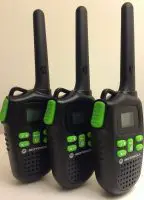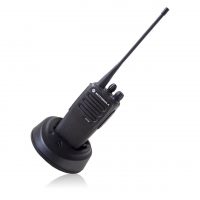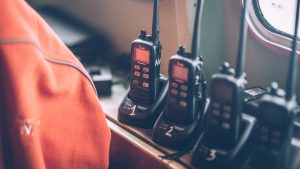Have you ever been in a situation where you are trying to talk to someone via a walkie-talkie but can only hear them and not vice versa? This is an issue that many people who use walkie-talkies have faced. Fortunately, there are several steps that you can take to troubleshoot your walkie-talkies so that they will work correctly. Let’s take a look at some of the common walkie-talkie issues including walkie-talkie working only one way and solutions.
Table of Contents
How Do Walkie-Talkies Work?
Have you ever wondered how walkie-talkies work? It’s an interesting technology that has been around for decades, and has recently seen a resurgence in popularity with the advent of smartphones. Whether you’re out camping, hunting, or just need to stay in touch with your friends, walkie-talkies can be a great way to keep connected.
Walkie-talkies are handheld two-way radios that allow users to communicate wirelessly over short distances. They use radio frequencies to transmit signals from one device to another, and each device is assigned a specific frequency so that other devices don’t pick up the signal.
To ensure that the signal is strong and clear, most walkie-talkies also have adjustable antennae that can be used to adjust the signal strength. This allows users to get better reception even in remote areas where there may be poor cell phone service.
Walkie-talkies are also equipped with various features, such as privacy codes and channel locks, which help prevent interference from other devices operating on the same frequency. Privacy codes allow users to set their own unique code that they can use when communicating with others who are using the same privacy code.
Channel locks allow users to lock their device onto a specific frequency so that it cannot be changed by anyone else without permission. These features help keep conversations private and secure even when multiple devices are operating on the same frequency.
Reasons for Walkie-Talkies Only Working One Way
Faulty Batteries
It can be quite frustrating to experience your walkie-talkie working only in one direction, especially when you are in the middle of crucial communication. However, there’s a chance that the problem could be solved with a simple check of the batteries. Ensuring that both walkie-talkies have properly functioning batteries is crucial, as a weak or dying battery could cause intermittent functionality, potentially disrupting your conversations.
Furthermore, in some cases, devices may continue to receive transmissions but become unable to send them due to insufficient battery power. A quick battery inspection or replacement will save not only valuable time spent on diagnostic troubleshooting but also establish clear and reliable communication, substantially improving your walkie-talkie experience. Remember, efficient communication is key, and maintaining adequate battery levels can go a long way.
Antenna Problems
Another common reason your walkie-talkies is working one way could be due to antenna problems. The antenna, a fundamental component of two-way radios, is responsible for receiving and transmitting signals to and from other devices. If the antenna is damaged or not properly connected, it can considerably hinder your device’s ability to receive or send out clear communication.
For instance, unwanted disruptions or weather conditions can impact the antenna’s position, resulting in poor signal reception. It is essential to regularly inspect the antenna, ensuring it is securely connected.
Channel Setting Issues
Your walkie-talkie may also be working only one way due to issues with the channel settings. When using a walkie-talkie, it is crucial to ensure that both devices are synced to the same channel and sub-channel; otherwise, you may find yourself in a one-sided conversation.

This is because each channel operates on a specific frequency. If your device is on a different channel than the one your companion’s device is tuned to, you won’t be able to hear their communications. Upon first glance, it might seem like your walkie-talkie is faulty, but it could just be a simple channel mismatch.
To rectify this issue, always double-check your channel settings before relying on your walkie-talkie for communication during important events or outdoor adventures. By being attentive to these settings, you can ensure functional two-way communication and enjoy the full benefits of your walkie-talkie.
Physical Damage
Among the various reasons, physical damage is the most common issue that can undermine the functionality of your walkie-talkies. As it is an essential communication tool for outdoor enthusiasts or those working in challenging environments, it can take a beating. Over time, accidents like drops, knocks, and exposure to extreme elements may cause the device’s internal components to crack or connections to loosen.
Interference Issues
Lastly, interference issues is another reason walkie-talkies may work one way. Interference occurs when multiple devices are operating in the same frequency range, causing signals to overlap and clash. It’s much like putting a hundred radio stations on the same channel; things are bound to get confusing!
Consequently, understanding interference issues can help you identify what might be causing the problem with your walkie-talkie and eventually help you fix it to ensure seamless communication.
The Benefits of Using Walkie-Talkies Over Smartphones
While smartphones may seem like an obvious choice for staying connected over long distances, there are several advantages of using walkie-talkies instead. For starters, walkie-talkies don’t require any type of internet connection or cell phone service in order for them to work – all you need is two devices tuned into the same frequency!
Furthermore, because phones use cellular networks, which can be unreliable in certain areas, walkie-talkies provide a more reliable connection than smartphones as long as both devices remain within the range of each other. Additionally, since most walkie-talkies come equipped with adjustable antennas, users can adjust their signal strength, depending on their location in order to get better reception and clearer sound quality than what is possible with smartphones alone.
Conclusion
Walkie-talkies can be an incredibly useful tool when communicating with others across distances or in remote locations, but it isn’t always easy getting it right. Fortunately, there are steps you can take if your walkies aren’t working correctly – such as checking their battery levels, ensuring their channel settings match each other’s, and making sure their antennas are properly connected and placed -to get them back up and running again!
Hopefully, this article has provided helpful insight into why your walkies might not be communicating properly – so you can get back out there using yours safely! If you want more information regarding walkie-talkies, make sure you visit our website.





